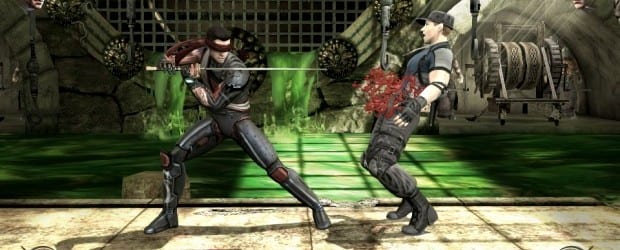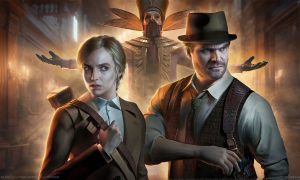
When Mortal Kombat came out last year, it rejuvenated the series. It moved the action back to a 2D plane, but the characters and backgrounds were all rendered in 3D. NetherRealm Studios pulled out all the stops with the Fatalities, making them even crazier and bloddier. The fighting engine was built from the ground-up using the Unreal 3 Engine. The developers wanted to make sure that Mortal Kombat included more strategy with a fast pace, and it was one of the games featured at the Evo Championship Series in 2011. Now a few months after the Vita launch, Mortal Kombat has made its way to the portable system, but can it stow everything away?
This edition of Mortal Kombat features the same 27 characters in the Xbox 360 and PS3 versions, as well as God of War antihero Kratos. Basically the roster from Ultimate Mortal Kombat 3 has come back to fight another day. This version also includes Skarlet, Kenshi, Rain, and Freddy Krueger, the four characters available as DLC in the big console versions. Each character has different moves, strengths, and speed. You won’t get bored because of a lack of characters to try. Eventually you will find one that matches your style, but that shouldn’t stop you from trying to learn all of the other characters to discover their strengths and weaknesses.
[singlepic id=6478 w=320 h=240 float=left]The fighting feels more like the classic 2D Mortal Kombat games. The 3D arenas are still there, but you fight against a 2D plane. This means that you won’t be side-stepping away from attacks like you could in previous games. The backgrounds do have depth while showing plenty of details, and they can be used for stage-specific fatalities. Each character has their own unique look to them, and you can still see plenty of details. While you can occasionally see large edges on the polygon of the characters, most of the characters look incredible, even if some of the costumes look like they stretch the bounds of double-sided tape. Bonus costumes are available in this version as well, so characters can have a different look if you unlock their alternate costumes in the Krypt.
Several modes are available for you to get your hands bloody. The story mode follows through the plot of the first three Mortal Kombat games. You don’t choose which character you play as, and it is a great introduction to all the character since it switches up the character you play often, similar to the Konquest mode in Mortal Kombat: Armageddon. There is also the traditional ladder match, where you fight other characters until you get to Goro and then Shao Khan. I will warn you, Shao Khan is a bit cheap, especially on the higher difficulty levels. The tag matches lets teams of two fight against each other. This is the first time this has been included in a Mortal Kombat game, and it is a nice addition to the mix.
The fighting is fast and smooth. Some of the classic moves are there, as well as new moves to update the characters. This time around, the face buttons represent the limbs of the characters instead of high and low punches and kicks. The Block button is still here, and you have to learn how to use it or else you could end up losing rather quickly. Knowing when to put up a strong defense is just as important as knowing when to attack. The moves list for every character is in the pause menu. I would highly recommend going into the Practice area and learn the moves of a particular character and then move on to another one to get a feel for all of the character’s special moves.
[singlepic id=6476 w=320 h=240 float=right]A new special gauge with three levels is located at the bottom of the screen. The first level allows you to to pull of an enhanced special move that looks slightly different and causes more damage. The second level gives you a Breaker that allow you to cancel out of a combo. When playing in a tag match, this can be a lifesaver. Finally there are the X-ray moves. These are the most powerful moves in the game which cause a ton of damage. The screen goes dark after successful activation of the the X-ray move, and all you have to do is sit and watch. You’ll see exactly what your attack is doing to your opponent as it shows their neck, spine, arms, and other bones being broken. It’s not uncommon to see organs rupture from the force of the hits. They are simply amazing to watch. If you have the X-ray move available, then you can push down the L and R buttons to activate it, or you can touch the pulsating X in the corner to get it to activate as well.
If the X-ray moves weren’t grotesque enough, the Fatalities make the X-ray moves look like a paper cut. While we’ve seen bodies being blown up or burned alive, you have never seen it done in such great detail. Seeing Sub-Zero freeze the legs of a body in ice before ripping of the torso at the waist is just brutal. Some of the stages even for their own fatality. Holding a character against an incoming subway train, making sure his or her face breaks every window, and then trowing him or her to the opposite side just as another subway train is passing through never gets old. You definitely don’t want anyone peering over and looking at what you are doing while playing this.
All of the modes that were present in the console version are included. The practice mode, story mode, fight modes, the Challenge Tower, verses mode, and krypt are all there. However, there are a few new modes included. The Test Your Might mini-game was a part of the original game, and it is included here, but now you get to Test Your Balance and Test Your Slice. During Test Your Balance the Vita’s internal tilt sensors are used to keep your balance on the screen. If you aren’t able to stay up, then you will drop and view all new fataility sequences. Test Your Slice is similar to Fruit Ninja, except body parts fly through the air for you to swipe on the screen.
[singlepic id=6473 w=320 h=240 float=left]If one Challenge Tower wasn’t enough for you, then the second bonus Challenge Tower should give you plenty of obstacles to occupy your time. A lot of these objectives are Vita-specific, using the special features of the handheld like the touch screen.
The controls aren’t bad. It does take a little getting used to the soft feel of the face buttons. The D-pad is slightly different from the DualShock 3 as well, since there isn’t any space between the directional keys. These are things that will get more familiar with more time with the hardware though. Performing special moves is relatively easy though, especially when they only require a quarter circle or a forward-backward movement. However, when you are playing a tag match you have to use the right stick to switch out characters. It’s almost impossible to combo a second character onto the screen since you have to hit a face button at the same time as the right stick, but if you have a lot of flexibility you can do it.
While a “Komplete Edition” was recently released for the consoles, the Vita version is the most complete version of them all. With the combination of classic and modern, the game really stands out in the fighting genre. It’s hard to believe that they were able to include with this system. If you already have a version for the PS3 or Xbox 360, this version might not be a necessary addition to your collection, but the Vita version gets the Flawless Victory on the go.
While not working as a Database Administrator, Keith Schleicher has been associated with Gaming Trend since 2003. While his love of video games started with the Telestar Alpha (a pong console with four different games), he trule started playing video games when he received the ill-fated TI-99/4A. While the Speech Synthesizer seemed to be the height of gaming, eventually a 286 AT computer running at 8/12 Hz and a CGA monitor would be his outlet for a while. Eventually he’d graduate to 386, 486, Pentium, and Athlon systems, building some of those systems while doing some hardware reviews and attending Comdex. With the release of the Dreamcast that started his conversion to the console world. Since then he has acquired an NES, SNES, PS2, PS3, PSP, GBA-SP, DS, Xbox, Xbox 360, Xbox One S, Gamecube, Wii, Switch, and Oculus Quest 2. While not playing video games he enjoys bowling, reading, playing board games, listening to music, and watching movies and TV. He originally hails from Wisconsin but is now living in Michigan with his wife and sons.


 Buy Now
Buy Now
 Buy Now
Buy Now
 Buy Now
Buy Now
 Buy Now
Buy Now
 Buy Now
Buy Now
 Buy Now
Buy Now















